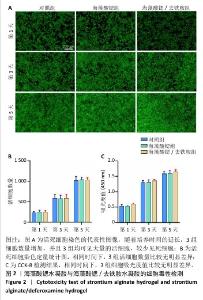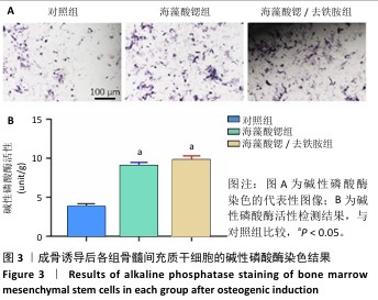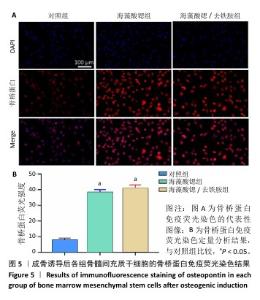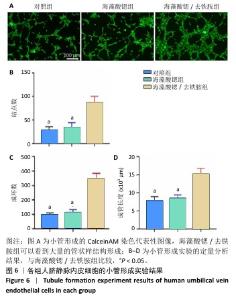Chinese Journal of Tissue Engineering Research ›› 2026, Vol. 30 ›› Issue (14): 3609-3617.doi: 10.12307/2026.031
Previous Articles Next Articles
Deferoxamine-loaded strontium alginate hydrogel promotes the repair of skull injury in rats
Wang Hao1, He Qin1, Wang Pingxi1, Zhang Jun2, Wu Zhilin1
- 1Department of Orthopedics, Dazhou Central Hospital, Dazhou 635000, Sichuan Province, China; 2Department of Orthopedics, First Affiliated Hospital of Chongqing Medical University, Chongqing 400014, China
-
Received:2025-02-12Accepted:2025-04-13Online:2026-05-18Published:2025-09-11 -
Contact:Zhang Jun, Associate researcher, Attending physician, Department of Orthopedics, First Affiliated Hospital of Chongqing Medical University, Chongqing 400014, China Wu Zhilin, Doctoral candidate, Department of Orthopedics, Dazhou Central Hospital, Dazhou 635000, Sichuan Province, China -
About author:Wang Hao, Associate chief physician, Department of Orthopedics, Dazhou Central Hospital, Dazhou 635000, Sichuan Province, China -
Supported by:National Natural Science Foundation of China, No. 82402779 (to ZJ); Chongqing Natural Science Foundation Project, No. CSTB2024NSCQ-MSX1218 (to ZJ)
CLC Number:
Cite this article
Wang Hao, He Qin, Wang Pingxi, Zhang Jun, Wu Zhilin. Deferoxamine-loaded strontium alginate hydrogel promotes the repair of skull injury in rats[J]. Chinese Journal of Tissue Engineering Research, 2026, 30(14): 3609-3617.
share this article
Add to citation manager EndNote|Reference Manager|ProCite|BibTeX|RefWorks
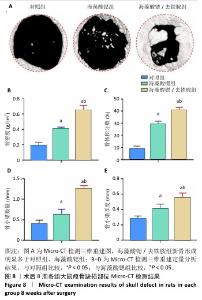
2.5 两种水凝胶修复大鼠骨缺损实验结果 2.5.1 实验动物数量分析 18只大鼠全部进入结果分析。 2.5.2 Micro-CT 检测 骨缺损部位Micro-CT三维重建显示,海藻酸锶/去铁胺组新骨形成明显多于对照组、海藻酸锶组,海藻酸锶组新骨形成多于对照组,见图8A。该实验结果可能与以下原因有关:一方面,海藻酸锶水凝胶可作为局部屏障阻止周围纤维组织进入骨缺损部位;另一方面,去铁胺具有促血管形成能力,通过血管生成加速骨再生。 定量分析结果显示,海藻酸锶组、海藻酸锶/去铁胺组骨密度、骨体积分数、骨小梁数量与骨小梁厚度均高于对照组(P < 0.05),海藻酸锶/去铁胺组骨密度、骨体积分数、骨小梁数量与骨小梁厚度均高于海藻酸锶组(P < 0.05),见图8B-D。"

| [1] ZHANG J, CHEN L, WANG J, et al. Multisite captured copper ions via phosphorus dendrons functionalized electrospun short nanofbrous sponges for bone regeneration. Adv Funct Mater. 2023;33:2211237. [2] ZHAO Y, CAI YF, WANG WK, et al. Periosteum-bone inspired hierarchical scaffold with endogenous piezoelectricity for neuro-vascularized bone regeneration. Bioact Mater. 2024;(24):339-353. [3] DUTTA SD, JIN HX, MD M, et al. Tailoring osteoimmunity and hemostasis using 3D-Printed nano-photocatalytic bactericidal scaffold for augmented bone regeneration. Biomaterials. 2025;316:122991. [4] KUNAL JR, SUN HL, FENG K, et al. Nanofibrous 3D scaffolds capable of individually controlled BMP and FGF release for the regulation of bone regeneration. Acta Biomater. 2024;190:50-63. [5] LIN ZX, CHEN ZX, CHEN YW, et al. Hydrogenated silicene nanosheet functionalized scaffold enables immuno-bone remodeling. Exploration (Beijing). 2023;3(4):20220149. [6] KOICHIRO HS, RYO K, AKIRA T, et al. Transformable Carbonate Apatite Chains as a Novel Type of Bone Graft. Adv Healthc Mater. 2024; 13(12):e2303245. [7] AO Y, GUO YL, ZHANG YZ, et al. Hypoxia-Mimicking Mediated Macrophage-Elimination of Erythrocytes Promotes Bone Regeneration via Regulating Integrin αvβ3/Fe2+-Glycolysis-Inflammation. Adv Sci (Weinh). 2024;1:e2403921. [8] HUANG L, ZHANG SH, BIAN MX, et al. Injectable, anti-collapse, adhesive, plastic and bioactive bone graft substitute promotes bone regeneration by moderating oxidative stress in osteoporotic bone defect. Acta Biomater. 2024;180:82-103. [9] GUO QL, CHEN JJ, BU QQ, et al. Establishing stable and highly osteogenic hiPSC-derived MSCs for 3D-printed bone graft through microenvironment modulation by CHIR99021-treated osteocytes. Mater Today Bio. 2024;26:101111. [10] ZHANG J, HUANG YR, WANG YP, et al. Construction of biomimetic cell-sheet-engineered periosteum with a double cell sheet to repair calvarial defects of rats. J Orthop Translat. 2022;38:1-11. [11] CAI WJ, MAO SH, WANG Y, et al. An Engineered Hierarchical Hydrogel with Immune Responsiveness and Targeted Mitochondrial Transfer to Augmented Bone Regeneration. Adv Sci (Weinh). 2024; 11:e2406287. [12] XIAO JH, ZHANG ZB, LI JH, et al. Bioinspired polysaccharide-based nanocomposite membranes with robust wet mechanical properties for guided bone regeneration. Natl Sci Rev. 2024; 11(3):nwad333. [13] FENG C, XUE JM, YU XP, et al. Co-inspired hydroxyapatite-based scaffolds for vascularized bone regeneration. Acta Biomater. 2021; 119:419-431. [14] ZHUANG Y, LIU QC, JIA GZ, et al. A Biomimetic Zinc Alloy Scaffold Coated with Brushite for Enhanced Cranial Bone Regeneration. ACS Biomater Sci Eng. 2021;7(3):893-903. [15] WANG JS, CHEN GB, CHEN ZM, et al. Current strategies in biomaterial-based periosteum scaffolds to promote bone regeneration: A review. J Biomater Appl. 2023;37(7):1259-1270. [16] EUGEN G, CLAUS M, ANNA-MARIA S, et al. Degradation of 3D-printed magnesium phosphate ceramics in vitro and a prognosis on their bone regeneration potential. Bioact Mater. 2022;19:376-391. [17] SIMUNOVIC F, FINKENZELLER G. Vascularization strategies in bone tissue engineering. Cells .2021;10(7):1749. [18] YAN CP, ZHANG PR, QIN QW, et al. 3D-printed bone regeneration scaffolds modulate bone metabolic homeostasis through vascularization for osteoporotic bone defects. Biomaterials. 2024; 311:122699. [19] WU XY, NI S, DAI T, et al. Biomineralized tetramethylpyrazine-loaded PCL/gelatin nanofibrous membrane promotes vascularization and bone regeneration of rat cranium defects. J Nanobiotechnology. 2023;21(1):423. [20] LIU JL, ZHOU ZZ, HOU MZ, et al. Capturing cerium ions via hydrogel microspheres promotes vascularization for bone regeneration. Mater Today Bio. 2024;24:25:100956. [21] NAMBIAR J, JANA S, NANDI SK. Strategies for Enhancing Vascularization of Biomaterial-Based Scaffold in Bone Regeneration. Chem Rec. 2022; 22(6):e202200008. [22] LI G, GAO F, YANG D, et al. ECM-mimicking composite hydrogel for accelerated vascularized bone regeneration. Bioact Mater. 2024;42: 241-256. [23] CHEN WK, SHENG SH, TAN K, et al. Injectable hydrogels for bone regeneration with tunable degradability via peptide chirality modification. Mater Horiz. 2024;11(18):4367-4377. [24] ZHOU LQ, CHEN DH, WU RC, et al. An injectable and photocurable methacrylate-silk fibroin/nano-hydroxyapatite hydrogel for bone regeneration through osteoimmunomodulation. Int J Biol Macromol. 2024;263(Pt 1):129925. [25] WU QJ, HU LW, YAN R, et al. Strontium-incorporated bioceramic scaffolds for enhanced osteoporosis bone regeneration. Bone Res. 2022;10(1):55. [26] LIU LJ, ZHANG ZY, AIMAI JM, et al. Strontium-Incorporated Carbon Nitride Nanosheets Modulate Intracellular Tension for Reinforced Bone Regeneration. Nano Lett. 2022;22(23):9723-9731. [27] HUANG JH, WEI JW, XIA X, et al. A sequential macrophage activation strategy for bone regeneration: A micro/nano strontium-releasing composite scaffold loaded with lipopolysaccharide. Mater Today Bio. 2024;26:101063. [28] MIAO AF, LI QS, TANG GL, et al. Alginate-containing 3D-printed hydrogel scaffolds incorporated with strontium promotes vascularization and bone regeneration. Int J Biol Macromol. 2024;273(Pt 1):133038. [29] NADI A, KHODAEI M, JAVDANI M, et al. Fabrication of functional and nano-biocomposite scaffolds using strontium-doped bredigite nanoparticles/polycaprolactone/poly lactic acid via 3D printing for bone regeneration. Int J Biol Macromol. 2022; 219:1319-1336. [30] ANWAR A, KANWAL Q, SADIQA A, et al. Synthesis and Antimicrobial Analysis of High Surface Area Strontium-Substituted Calcium Phosphate Nanostructures for Bone Regeneration. Int J Mol Sci. 2023; 24(19):14527. [31] BAHEIRAEI N, EYNI H, BAKHSHI B, et al. Effects of strontium ions with potential antibacterial activity on in vivo bone regeneration. Sci Rep. 2021;22;11(1):8745. [32] ZHAO YN, SUN W, WU XY, et al. Janus Membrane with Intrafibrillarly Strontium-Apatite-Mineralized Collagen for Guided Bone Regeneration. ACS Nano. 2024;18(9):7204-7222. [33] CHEN S, CHENG DW, WEIMIN BAO WM, et al. Polydopamine-Functionalized Strontium Alginate/Hydroxyapatite Composite Microhydrogel Loaded with Vascular Endothelial Growth Factor Promotes Bone Formation and Angiogenesis. ACS Appl Mater Interfaces. 2024;16(4):4462-4477. [34] HOLDEN P, NAIR LS. Deferoxamine: An Angiogenic and Antioxidant Molecule for Tissue Regeneration. Tissue Eng Part B Rev. 2019;25(6): 461-470. [35] SHEN HJ, ZHANG C, MENG Y, et al. Biomimetic Hydrogel Containing Copper Sulfide Nanoparticles and Deferoxamine for Photothermal Therapy of Infected Diabetic Wounds. Adv Healthc Mater. 2024;13(8): e2303000. [36] SHEN HJ, MA Y, QIAO Y, et al. Application of Deferoxamine in Tissue Regeneration Attributed to Promoted Angiogenesis. Molecules. 2024; 29;29(9):2050. [37] WANG RK, ZHA XJ, CHEN JC, et al. Hierarchical Composite Scaffold with Deferoxamine Delivery System to Promote Bone Regeneration via Optimizing Angiogenesis. Adv Healthc Mater. 2024;20:e2304232. [38] ZENG YW, HUANG C, DUAN DM, et al. Injectable temperature-sensitive hydrogel system incorporating deferoxamine-loaded microspheres promotes H-type blood vessel-related bone repair of a critical size femoral defect. Acta Biomater. 2022;153:108-123. [39] LIU Z, HUANG LZ, QI L, et al. Activating Angiogenesis and Immunoregulation to Propel Bone Regeneration via Deferoxamine-Laden Mg-Mediated Tantalum Oxide Nanoplatform. ACS Appl Mater Interfaces. 2024;16(19):24384-24397. [40] XU DL, GAN KF, WANG Y, et al. A Composite Deferoxamine/Black Phosphorus Nanosheet/Gelatin Hydrogel Scaffold for Ischemic Tibial Bone Repair. Int J Nanomedicine. 2022;17:1015-1030. [41] LIU H, LI K, YI DL, et al. A Composite Deferoxamine/Black Phosphorus Nanosheet/Gelatin Hydrogel Scaffold for Ischemic Tibial Bone Repair. J Funct Biomater. 2024;15(4):112. [42] TIAN S, MEI JW, ZHANG LS, et al. Multifunctional Hydrogel Microneedle Patches Modulating Oxi-inflamm-aging for Diabetic Wound Healing. Small. 2024;3:e2407340. [43] ZHANG P, YANG JH, WANG ZY, et al. An injectable self-lubricating supramolecular polymer hydrogel loaded with platelet lysate to boost osteoarthritis treatment. J Control Release. 2024;376:20-36. [44] LIU DG, WANG XY, GAO CY, et al. Biodegradable Piezoelectric-Conductive Integrated Hydrogel Scaffold for Repair of Osteochondral Defects. Adv Mater. 2024;13:e2409400. [45] NUNES LA, LUCIENE M, ROSSE O, et al. High ferritin is associated with liver and bone marrow iron accumulation: Effects of 1-year deferoxamine treatment in hemodialysis-associated iron overload. PLoS One. 2024;19(8):e0306255. [46] LI SB, WANG XM, CHEN J, et al. Calcium ion cross-linked sodium alginate hydrogels containing deferoxamine and copper nanoparticles for diabetic wound healing. Int J Biol Macromol. 2022;202:657-670. |
| [1] | Sun Lei, Zhang Qi, Zhang Yu. Pro-osteoblastic effect of chlorogenic acid protein microsphere/polycaprolactone electrospinning membrane [J]. Chinese Journal of Tissue Engineering Research, 2026, 30(8): 1877-1884. |
| [2] | Li Qingbin, Lin Jianhui, Huang Wenjie, Wang Mingshuang, Du Jiankai, Lao Yongqiang. Bone cement filling after enlarged curettage of giant cell tumor around the knee joint: a comparison of subchondral bone grafting and non-grafting [J]. Chinese Journal of Tissue Engineering Research, 2026, 30(8): 1896-1902. |
| [3] | Guo Yuchao, Ni Qianwei, Yin Chen, Jigeer·Saiyilihan, Gao Zhan . Quaternized chitosan hemostatic materials: synthesis, mechanism, and application [J]. Chinese Journal of Tissue Engineering Research, 2026, 30(8): 2091-2100. |
| [4] | Lai Yu, Chen Yueping, Zhang Xiaoyun. Research hotspots and frontier trends of bioactive materials in treating bone infections [J]. Chinese Journal of Tissue Engineering Research, 2026, 30(8): 2132-2144. |
| [5] | Zhou Hongli, Wang Xiaolong, Guo Rui, Yao Xuanxuan, Guo Ru, Zhou Xiongtao, He Xiangyi. Fabrication and characterization of nanohydroxyapatite/sodium alginate/polycaprolactone/alendronate scaffold [J]. Chinese Journal of Tissue Engineering Research, 2026, 30(8): 1962-1970. |
| [6] | Wang Yu, Fan Minjie, Zheng Pengfei. Application of multistimuli-responsive hydrogels in bone damage repair: special responsiveness and diverse functions [J]. Chinese Journal of Tissue Engineering Research, 2026, 30(2): 469-479. |
| [7] | . Effect of mussel-derived antimicrobial peptide-coated modified prosthesis on prevention of early periprosthetic joint infection and regulation of bone transfer [J]. Chinese Journal of Tissue Engineering Research, 2026, 30(2): 278-287. |
| [8] | Guo Jingwen, Wang Qingwei, He Zijun, Hu Zihang, Chen Zhi, Zhu Rong, Wang Yuming, Liu Wenfei, Luo Qinglu. Intra-articular injection of different concentrations of silicon-based bioceramics in treatment of knee osteoarthritis in rats [J]. Chinese Journal of Tissue Engineering Research, 2026, 30(2): 288-295. |
| [9] | Xu Wenhe, Li Xiaobing, Liu Fang. Functionalized biomimetic mineralized collagen modified orthopedic implants [J]. Chinese Journal of Tissue Engineering Research, 2026, 30(2): 516-527. |
| [10] | Zhou Shibo, Yu Xing, Chen Hailong, Xiong Yang. Nanocrystalline collagen-based bone combined with Bushen Zhuangjin Decoction repairs bone defects in osteoporotic rats [J]. Chinese Journal of Tissue Engineering Research, 2026, 30(2): 354-361. |
| [11] | Liu Xiaohong, Zhao Tian, Mu Yunping, Feng Wenjin, Lyu Cunsheng, Zhang Zhiyong, Zhao Zijian, Li Fanghong. Acellular dermal matrix hydrogel promotes skin wound healing in rats [J]. Chinese Journal of Tissue Engineering Research, 2026, 30(2): 395-403. |
| [12] | Yuan Qian, Zhang Hao, Pang Jie. Characterization and biological properties of naringin-loaded chitosan/beta-tricalcium phosphate scaffold [J]. Chinese Journal of Tissue Engineering Research, 2026, 30(2): 424-432. |
| [13] | Kong Xiaojuan, Tan Zhenyu, Lei Lei. Repair of rat endometrial injury by using miR-424-5p modified exosome/Poloxam 407 hydrogel [J]. Chinese Journal of Tissue Engineering Research, 2026, 30(14): 3626-3635. |
| [14] | Li Liang, Yang Han, Suo Hairui, Guan Lu, Wang Zhenlin. 3D printed methacrylated gelatin/chitosan scaffolds: evaluation of antibacterial, mechanical properties and cytocompatibility [J]. Chinese Journal of Tissue Engineering Research, 2026, 30(14): 3636-3642. |
| [15] | Yang Biao, , Wu Zhonghuan, , Jiang Fugui, , He Chenglong, , Li Tingdong, . Conductive hydrogel with cell-free fat extract repairs spinal cord injuries in rats [J]. Chinese Journal of Tissue Engineering Research, 2026, 30(14): 3652-3662. |
| Viewed | ||||||
|
Full text |
|
|||||
|
Abstract |
|
|||||


